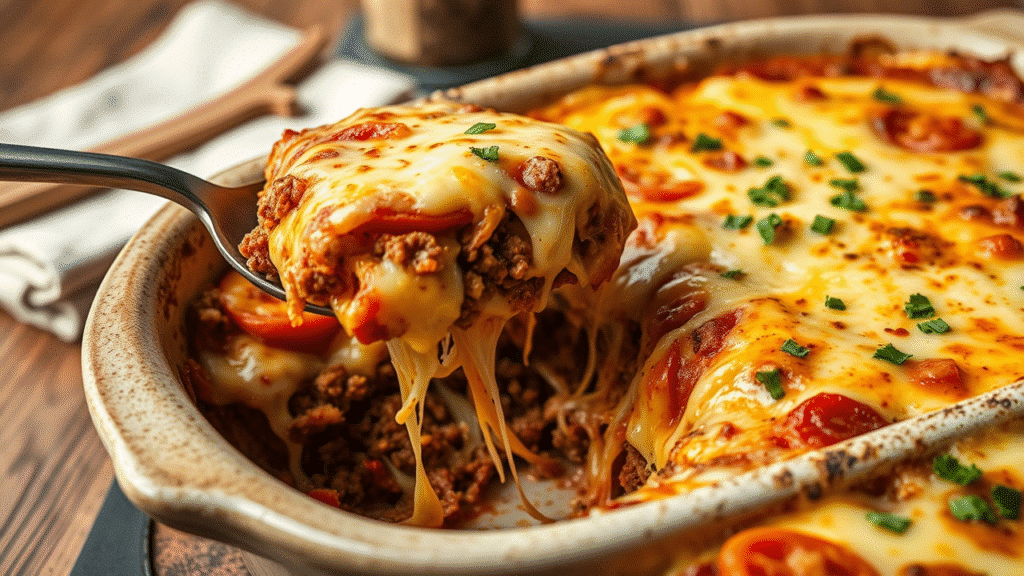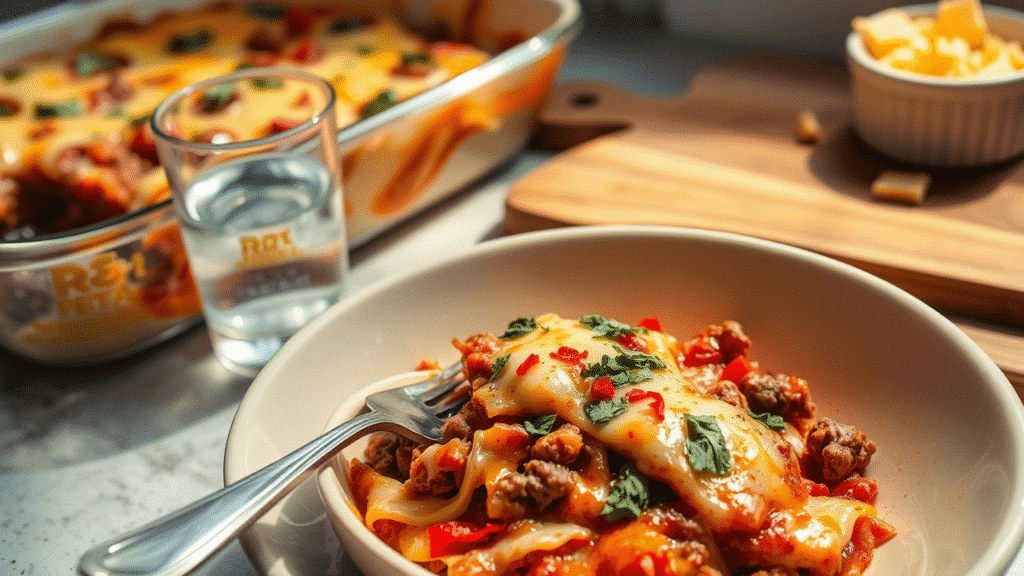The night my Italian grandmother discovered I was avoiding carbs, she looked at me like I’d personally insulted her ancestors. “How can you live without pizza?” she asked, gesturing dramatically with her wooden spoon. That challenge sparked a three-month obsession with recreating the soul-warming comfort of her Sunday pizza nights without derailing anyone’s ketogenic goals. What emerged from countless kitchen experiments was something that surprised even her a casserole that captured every essence of great pizza while actually being more satisfying than the original.
This keto pizza casserole isn’t just another low-carb substitution dish it’s a complete reimagining of how pizza flavors can be structured and delivered. The genius lies in treating pizza as a flavor profile rather than a format, allowing us to concentrate all those beloved tastes into a dense, protein-rich casserole that provides genuine comfort food satisfaction. Unlike traditional pizza where the crust often serves as little more than a delivery mechanism, this recipe makes every bite count nutritionally and flavor-wise.
What makes this casserole truly special is how it solves the fundamental problem with most keto pizza alternatives—texture disappointment. By building layers of complementary proteins and fats, we create a dish that’s substantial enough to satisfy the heartiest appetites while maintaining that familiar pizza experience. The technique involves creating distinct flavor layers that mirror the pizza experience: a rich, meaty base, tangy sauce integration, and that irresistible cheese pull that makes pizza so emotionally satisfying.
Ingredients & Substitutions
Protein Foundation Layer:
- 1 lb ground Italian sausage (85/15 fat ratio)
- 1 lb ground beef (80/20 blend)
- 8 oz pepperoni, diced
- 6 large eggs
- 1 cup ricotta cheese (whole milk)
- 8 oz cream cheese, softened
Vegetable Components:
- 1 large bell pepper, diced
- 1 medium onion, finely chopped
- 8 oz mushrooms, sliced (baby bella preferred)
- 4 cloves garlic, minced
- 2 tablespoons olive oil
Sauce & Seasoning Matrix:
- 1 cup sugar-free marinara sauce
- 2 tablespoons tomato paste
- 2 teaspoons Italian seasoning
- 1 teaspoon dried oregano
- 1 teaspoon dried basil
- ½ teaspoon red pepper flakes
- 1 teaspoon garlic powder
- Salt and black pepper to taste
Cheese Blend:
- 2 cups mozzarella cheese, shredded (low-moisture)
- 1 cup sharp cheddar, shredded
- ½ cup Parmesan cheese, grated
- ¼ cup Romano cheese, grated
Optional Toppings:
- Additional pepperoni slices
- Black olives, sliced
- Fresh basil leaves
- Crushed red pepper
The sausage selection dramatically impacts your final result look for brands with minimal fillers and no added sugars. Sweet Italian sausage works beautifully, but spicy versions add complexity that elevates the entire dish. Johnsonville and Aidells both produce excellent options, though local butcher shops often carry superior products with better spice blends and higher meat content.
Ground beef quality matters tremendously here. The 80/20 blend provides optimal fat content for both flavor and texture—leaner blends will create a dry, less satisfying casserole while fattier options can make it greasy. Grass-fed beef adds depth and richness, though conventional beef works perfectly fine. Avoid ground turkey or chicken as primary proteins; they lack the richness needed to carry the dish’s flavor profile.
Ricotta cheese serves as more than just a creamy element it acts as a binding agent that helps create the casserole’s structure. Whole milk ricotta is essential; part-skim versions contain stabilizers that can create a grainy texture when baked. For those avoiding dairy, cashew ricotta works surprisingly well, though you’ll need to add extra eggs to compensate for binding properties.
The marinara sauce choice can make or break this recipe. Rao’s Homemade offers excellent flavor with no added sugars, while Primal Kitchen provides a slightly sweeter profile that many prefer. Always check labels carefully many commercial marinara sauces contain hidden sugars that can significantly impact your carb count.
Mozzarella quality directly affects the cheese pull factor that makes pizza so satisfying. Low-moisture mozzarella melts more predictably and creates better texture than fresh mozzarella, which can release too much water during baking. Avoid pre-shredded cheese when possible freshly grated melts more evenly and tastes significantly better.
Step-by-Step Instructions

Foundation Preparation (15 minutes): Preheat your oven to 375°F and generously grease a 9×13 inch baking dish with olive oil or butter. The fat coating prevents sticking and contributes to the overall richness of the finished dish. Position your oven rack in the center position to ensure even heat distribution throughout the cooking process.
Heat a large skillet over medium-high heat and add the olive oil. Once the oil shimmers slightly, add the diced onion and cook for 3-4 minutes until it begins to soften and develop some color around the edges. The slight caramelization adds sweetness that balances the acidity of the tomato sauce later.
Add the minced garlic and sliced mushrooms to the skillet, stirring to combine with the onions. Cook for another 4-5 minutes until the mushrooms release their moisture and begin to brown slightly. This step is crucial undercooked mushrooms will release water during baking and make your casserole soggy.
Meat Layer Development (12 minutes): Push the vegetables to one side of your skillet and add the ground sausage and beef to the empty space. Don’t mix immediately let the meat brown undisturbed for 2-3 minutes to develop proper caramelization. This creates flavor compounds that can’t be achieved through seasoning alone.
Break up the meat with a wooden spoon and mix with the vegetables, cooking until the meat is completely browned and no pink remains. The mixture should look dry rather than wet if there’s excessive liquid, drain it off to prevent a soggy casserole. Season with salt, pepper, and half of your Italian seasoning blend.
Add the diced pepperoni to the meat mixture and cook for another 2 minutes. The pepperoni will release its oils and spices, creating a flavor base that permeates the entire dish. Remove from heat and let cool slightly while you prepare the cheese mixture.
Cheese Matrix Creation (8 minutes): In a large bowl, whisk the eggs until they’re completely smooth and uniform in color. Add the ricotta and softened cream cheese, whisking until the mixture is completely smooth with no lumps. This creates your binding matrix that holds everything together during baking.
Add the marinara sauce, tomato paste, remaining Italian seasoning, oregano, basil, red pepper flakes, and garlic powder to the cheese mixture. Whisk until everything’s evenly distributed and the mixture has a uniform color. Taste and adjust seasoning—it should be slightly over-seasoned since the flavors will mellow during baking.
Fold in 1½ cups of the mozzarella, ¾ cup of the cheddar, and all of the Parmesan cheese. Reserve the remaining cheese for topping. The mixture should be thick but pourable if it seems too thick, add a tablespoon of water or cream.
Assembly and Layering (10 minutes): Spread the cooked meat and vegetable mixture evenly across the bottom of your prepared baking dish. Press it down lightly to create a uniform layer that will support the cheese mixture above. This creates the foundation that mimics a pizza crust in terms of substance and texture.
Pour the cheese mixture over the meat layer, using a spatula to spread it evenly to all corners of the dish. The mixture should completely cover the meat layer if you have bare spots, it won’t bake evenly. Gently shake the dish to help the cheese mixture settle into any gaps.
Sprinkle the reserved mozzarella and cheddar cheese evenly over the top, followed by the Romano cheese. If using additional pepperoni or other toppings, add them now. The final layer should look generous cheese is what makes this dish indulgent and satisfying.
Baking Process (35 minutes): Cover the dish with aluminum foil and bake for 25 minutes. The foil prevents the top from browning too quickly while allowing the interior to set properly. You’ll know it’s ready when the edges are bubbling and the center feels firm when gently pressed.
Remove the foil and continue baking for 8-10 minutes until the cheese is golden brown and bubbly. If you want more browning, switch to the broil setting for the last 2-3 minutes, watching carefully to prevent burning. The finished casserole should be golden brown on top with bubbling edges.
Let the casserole rest for 10-15 minutes before serving. This resting period allows the proteins to set properly and makes slicing much easier. The internal temperature should reach 165°F when measured with a meat thermometer.
Cooking Techniques & Science
The success of this keto pizza casserole relies on understanding protein coagulation and fat emulsification. The eggs act as a primary binding agent, coagulating during cooking to create structure, while the ricotta and cream cheese provide richness and help create a cohesive texture that slices cleanly when cooled.
Moisture management is critical in casserole cooking. Traditional pizza dough absorbs excess moisture, but in this recipe, we must manage water content through proper vegetable prep and protein selection. Pre-cooking the vegetables removes excess water that would otherwise create a soggy final product.
The layering technique isn’t just about presentation it’s about creating distinct flavor experiences within each bite. The meat layer provides umami richness and textural contrast, while the cheese layer delivers the creamy, tangy elements that make pizza satisfying. This stratification prevents flavors from muddling together during the long baking process.
Maillard reactions occur both during the initial browning of the meat and vegetables and again during the final baking phase. These reactions create hundreds of flavor compounds that add complexity and depth to the finished dish. The slight caramelization of the cheese during the final uncovered baking stage contributes significantly to the overall flavor profile.
The resting period after baking isn’t just practical it’s scientifically necessary. Proteins continue to coagulate and set during this time, while fats resolidify slightly, creating the proper texture for clean slicing. Cutting too early results in a runny, difficult-to-serve casserole that doesn’t hold its shape.
Temperature control during baking ensures even cooking throughout the thick casserole. The initial covered baking phase creates a steaming environment that cooks the interior gently, while the final uncovered phase allows surface browning and moisture evaporation.
Serving & Pairing Suggestions
This keto pizza casserole serves 8-10 people generously, making it perfect for family dinners or meal prep situations. Each serving provides approximately 4 net carbs, 28 grams of protein, and 35 grams of fat, creating ideal macronutrient ratios for ketogenic dieters.
Serve in generous squares on warmed plates to maintain temperature and enhance the comfort food experience. The visual presentation should emphasize the generous cheese layer and rich, meaty interior. A simple garnish of fresh basil leaves adds color and aromatic appeal that enhances the overall dining experience.
Pair with a crisp Caesar salad dressed with extra Parmesan and anchovies to complement the Italian flavors. The acidity and crunch provide perfect textural contrast to the rich, creamy casserole. Roasted vegetables like zucchini, bell peppers, or asparagus also work beautifully as lighter accompaniments.
For beverages, consider Italian reds like Chianti or Sangiovese that complement the tomato and herb flavors without overpowering the dish. Beer lovers should try a crisp lager or light wheat beer that refreshes the palate between rich bites.
The casserole reheats beautifully, making it excellent for meal prep or leftover situations. Individual portions can be frozen for up to three months, providing convenient keto-friendly meals that actually taste better than most fresh fast food options.
Consider serving with sugar-free marinara sauce on the side for those who prefer extra sauce. A sprinkle of red pepper flakes or grated Parmesan at the table allows diners to customize their experience according to their preferences.
Advanced Variations & Customizations

The base recipe serves as a foundation for countless variations that can keep your keto pizza casserole repertoire interesting throughout the year. Try adding different vegetables like roasted eggplant, sun-dried tomatoes, or artichoke hearts for Mediterranean flair that adds complexity without significantly impacting carb counts.
Meat variations can completely transform the dish’s character. Try using ground lamb with rosemary and garlic for a Greek-inspired version, or substitute the beef with ground turkey and add fresh herbs like thyme and sage for a lighter profile. Bacon and ham combinations create a breakfast pizza casserole that works beautifully for brunch applications.
Cheese combinations offer another avenue for customization. Goat cheese and fresh mozzarella create a tangy, creamy version that’s particularly appealing to sophisticated palates. Smoked cheeses like smoked mozzarella or gouda add depth and complexity that transforms the entire flavor profile.
Spice level adjustments can accommodate different heat preferences. Jalapeños, hot Italian sausage, or additional red pepper flakes can amp up the heat, while sweet bell peppers and mild herbs create family-friendly versions that please even sensitive palates.
Conclusion
This keto pizza casserole proves that successful low-carb cooking isn’t about deprivation it’s about understanding how to manipulate flavors and textures to create satisfaction without relying on traditional starches. The key lies in building layers of complementary proteins and fats that provide both nutritional value and genuine comfort food appeal.
The most important takeaway is that casseroles allow for incredible flexibility within ketogenic parameters. Once you master the basic technique of protein binding and moisture management, you can adapt the concept to virtually any flavor profile while maintaining the structural integrity that makes the dish satisfying.
Don’t be afraid to experiment with different combinations once you’ve mastered the base recipe. The beauty of this approach is that it’s nearly impossible to create a complete failure the worst-case scenario is usually just a slightly different but still delicious variation on the theme.
Remember that the best keto comfort foods are those that don’t feel like compromises. This casserole should satisfy your pizza cravings completely, not just serve as an acceptable substitute. When you achieve that level of satisfaction, sustainable low-carb eating becomes genuinely enjoyable rather than a burden.
FAQs
Can I prepare this casserole ahead of time and bake it later?
Absolutely! This casserole actually benefits from being assembled a day ahead, as the flavors have time to meld together. Assemble completely, cover tightly with plastic wrap, and refrigerate for up to 24 hours before baking. Add an extra 5-10 minutes to the covered baking time since you’re starting with a cold casserole. You can also freeze the assembled casserole for up to 3 months—just thaw completely in the refrigerator before baking.
Why does my casserole sometimes turn out watery or soggy?
Excess moisture usually comes from not properly pre-cooking the vegetables or using ingredients with high water content. Make sure your mushrooms are well-browned and have released their moisture during the sautéing phase. Also, check your marinara sauce—some brands are thinner than others and may need to be reduced slightly before adding to the casserole. If your ricotta seems particularly wet, drain it in a fine-mesh strainer for 30 minutes before using.
Can I substitute the eggs with something else for an egg-free version?
Eggs are crucial for binding in this recipe, but you can substitute with a flax egg mixture (3 tablespoons ground flaxseed mixed with 9 tablespoons water, let sit for 15 minutes) or commercial egg replacer. However, the texture will be slightly different—less firm and more crumbly. Adding an extra 4 oz of cream cheese can help compensate for some of the binding properties you lose without eggs.
What are the best ways to reheat leftovers?
For best results, reheat individual portions in the oven at 350°F for 15-20 minutes, covered with foil to prevent drying out. Microwave reheating works for quick meals use 50% power for 2-3 minutes, stirring halfway through. The casserole can also be reheated in a skillet over medium-low heat with a tight-fitting lid, which actually creates a nice crispy bottom layer that many people prefer.
How can I make this casserole dairy-free while keeping it keto?
Replace the ricotta with cashew ricotta or mashed silken tofu, use coconut cream instead of cream cheese, and substitute the regular cheeses with dairy-free alternatives like Miyoko’s or Violife brands. You may need to add extra eggs or a binding agent like tapioca starch to maintain structure. The flavor will be different but still satisfying consider adding extra herbs and spices to compensate for the reduced richness from dairy fats.

